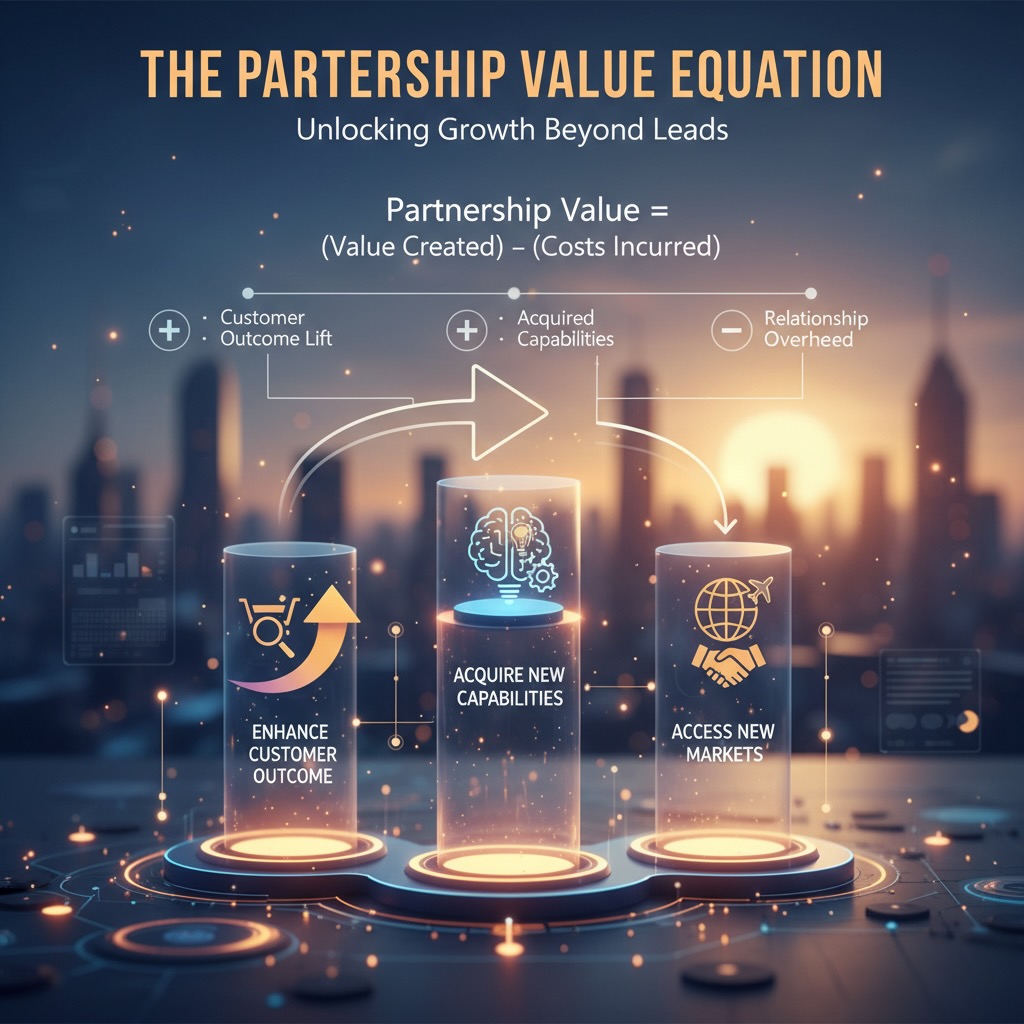
Beyond the Handshake: Deconstructing Partnership Value from First Principles
You've just left the meeting. The partnership looks perfect on paper—great brand alignment, a similar audience, and a signed agreement. But three months later, nothing has happened. The initial excitement has faded, replaced by stalled projects and unanswered emails. Sound familiar?
This all-too-common scenario happens because we often mistake the agreement—the handshake—for the value itself. We get caught up measuring success with lagging indicators like leads generated or revenue influenced, rather than confirming foundational alignment from the start.
It's no surprise, then, that studies from Harvard Business Review show that somewhere between 60 and 70 percent of joint ventures and business alliances ultimately fail.
So, how do you get on the right side of that statistic?
To build strategic partnerships that are valuable by design, not by chance, we need to stop reasoning by analogy and start thinking like a physicist. We must break down partnership value to its fundamental truths—its first principles (a much more complicated effort than it may seem at first glance).
The Flaw in Our Thinking: Why "Copycat" Partnerships Stall
Most businesses evaluate partnerships by analogy. We see a competitor's wildly successful co-marketing campaign, like the legendary GoPro and Red Bull collaboration, and we try to copy the tactic without ever understanding the foundational value that made it work in the first place.
This "copycat" approach is why so many partnership managers struggle to answer a critical question from their leadership:
"How do I convince you to invest in a long-term partnership that won't show ROI for over six months?"
When you only copy tactics, you can only point to surface-level metrics, which often aren't enough to justify a long-term investment.
The solution is to change the way we think. As Elon Musk explains:
"The normal way we conduct our lives is we reason by analogy... First principles is kind of a physics way of looking at the world. You boil things down to the most fundamental truths... and then reason up from there."
Instead of asking, "What did a successful partnership look like?" we need to ask, "What are the fundamental truths of a valuable partnership?"
The 3 Foundational Pillars of Partnership Value
After breaking it down, we find that any truly successful business alliance must deliver on at least one of three fundamental pillars. These are the bedrock of partnership value.
Pillar 1: Enhance the Customer Outcome
This is the most crucial pillar. Forget your company for a moment and focus on your customer. Does the partnership make your product or service fundamentally better, faster, or more complete for the end user?
- Product Example: An analytics software company integrates with a data provider. The result? Customers can now generate richer, more accurate reports without leaving the platform—a clear and immediate enhancement to their outcome.
- Service Example: As VP of Strategic Partnerships at JCDecaux, my team developed award-winning campaign effectiveness measurement plans. This partnership-driven solution provided our advertisers (the customers) with undeniable proof of their ROI, fundamentally improving the outcome of their media investment.
Pillar 2: Acquire New Capabilities
Some goals are too expensive, time-consuming, or far outside your core competency to build in-house. A strategic partnership can grant you access to technology, data, expertise, or processes you don't currently possess.
- Technology Example: A retail brand partners with a specialized AI firm to build a product recommendation engine, a capability that would have taken years and a team of data scientists to develop internally.
- Data Example: While at Audience Town, I negotiated a long-term agreement for a US consumer database at 70% below market cost. This partnership didn't just save money; it acquired a critical capability that powered a new analytics product and drove 100% year-over-year revenue growth.
Pillar 3: Access New Markets
Finally, a partnership can provide a credible and efficient entry point to a new customer segment, geography, or distribution channel that would otherwise be inaccessible.
- Geography Example: A US-based SaaS company signs a deal with a well-established European distributor to navigate complex local regulations and gain immediate market presence.
- Audience Example: During my time at Movado Group, a key initiative was to create relationships with digital-only publishers. This allowed us to gain unique audience exposure beyond traditional print media, accessing a new generation of customers where they spent their time.
Ready to analyze your own partnerships? Download our free First Principles Partnership Scorecard to see how your current alliances stack up against the three pillars of value.
From Principles to Practice: A Simple Value Equation
This framework directly helps with the most common pain point partnership leaders face:
"How do I prove the value of a partnership that doesn't generate direct leads?"
You can frame the holistic partnership ROI with a simple, conceptual formula. This isn't a strict calculator, but a thinking tool to force a complete view of the value created and the costs incurred.
Partnership Value = (Customer Outcome Lift + Acquired Capabilities + Market Access) - (Integrations Costs + Relationship Overhead)
Let's apply this to the database deal mentioned earlier. The value wasn't just in the "Acquired Capabilities" bucket. Because we secured it at 70% below market rate, it drastically lowered the cost side of the equation, making the total value immense and easy to articulate. This model gives you a language to explain why a partnership that doesn't produce a single lead can still be one of the most valuable initiatives your company undertakes. It's the foundation for true Ecosystem-Led Growth.
The Takeaway: Build on Bedrock, Not Sand
The most resilient and profitable partnerships aren't built on flimsy handshakes or copycat tactics. They are constructed on a bedrock of clearly understood, fundamental value. By using first principles thinking, you can move beyond chasing vanity metrics and start designing alliances that are valuable by design, not by chance.
The legendary management consultant Peter Drucker said that a business really only has two functions: marketing and innovation. A great partnership must fundamentally serve one or both. By evaluating every potential alliance against the three pillars— Enhance Customer Outcome, Acquire Capabilities, and Access New Markets—you ensure your efforts are always tied to what matters most.
Once you've identified the foundational value using this framework, the next challenge is executing strategic partnership conversations. For a practical approach to partnership calls, see The Jazz of Partnerships framework.
Stop guessing. Take one potential or current partnership this week and analyze it using this framework. Ditch the generic KPI checklist and identify the true, foundational value. What pillar does it serve? How can you maximize its contribution?
The Invitation
Ready to move beyond handshakes and unlock the true value of your partnerships?
For individuals:
Reach out directly to discuss how you can apply this partnership value framework to your current relationships.
For organizations: Ready to transform how your team evaluates partnerships?
Let's discuss how you can implement systematic partnership evaluation frameworks that help your team identify, measure, and maximize the true value of strategic relationships.
Start the Conversation →